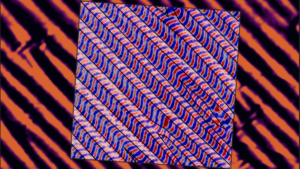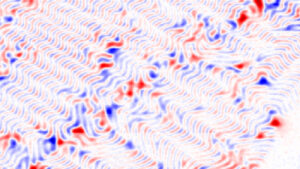In their recent publication, physics assistant professor, Paul Stevenson, and his collaborative team from Northeastern University, Brown University, Rice University, and University of California Berkeley reveal groundbreaking advancements in utilizing isolated spins in solids. Their work, enabled by the Quantum Materials and Sensing Institute, pioneers ultrasensitive nanoscale sensors and quantum communication technologies. Through interdisciplinary efforts, they delve into probing nanoscale biophysical dynamics and advancing antiferromagnetic spintronics, particularly in electric-field controllable magnetic devices using materials like Bismuth ferrite (BiFeO3).
To learn more about their research, I spoke with Paul Stevenson discussing the implications of new materials in the world of physics and the importance of collaborative research. Read the publication, “Persistent anisotropy of the spin cycloid in BiFeO3 through ferroelectric switching,” here.
What first drew your attention to antiferromagnetic spintronics, particularly in relation to controlling spin configuration on nanometer scales?
The overall motivation is driven by need to make more energy-efficient computers. The amount of energy that we spend doing computation is growing much faster than we generate energy. This drives the need for low power and more efficient ways to do computations, so we need to find alternatives to serve traditional silicon transistors.
Finding alternatives is difficult because we’re already so good at making silicon devices, so there isn’t much room to keep improving. It’s scary and exciting because it suggests we should start looking elsewhere and for new types of materials that aren’t in conventional silicon chips, which is where bismuth ferrite comes in.

Could you explain why bismuth ferrite (BiFeO3) is considered a promising material for electric-field controllable magnetic devices, given its multiferroic properties?
The main attractive things about bismuth ferrite are that we can change its magnetic properties with voltages and that it works at room temperature. There are a lot of interesting multiferroic materials from a physics and fundamental science perspective, but many of them only work at very low temperatures. If we’re trying to be energy efficient, cooling things down to liquid nitrogen temperatures is the opposite of what we’re looking for.
From a physics perspective, it’s interesting because a lot of very complicated behavior bundled into one package. The things that make it useful (that the different types of order all talk to each other) also make it difficult to understand, which is why it’s taken such a long time to start maturing as a technology.
Piece by piece, we are learning how all these different parts fit together. How magnetism interacts with its response to electric field and how that does or doesn’t couple to strain in the material, and how that changes depending on the different ways that we make or treat it.

What were some of the key challenges you encountered during your research, and how did you overcome them?
This is one of the more straightforward research projects I’ve done, thanks to the new tools and equipment in the Quantum Materials and Sensing Institute. There’s a lot of complicated interpretation that goes into the data, however, but thankfully we’ve had a lot of support from collaborators and a lot of great work that’s been done in the field already that helped us understand what we were seeing.
The conventional challenged with this research is that the magnetism varies on length scales of tens of nanometers, which makes it great in terms of being able to make things very compact b But it becomes very difficult to find experimental techniques that can be sensitive and reach down to those length scales.
That’s where the scanning diamond magnetometer that we have at the Quantum Materials and Sensing Institute comes in because it combines that sensitivity and that very high spatial resolution.
How do you envision your study’s findings influencing future research directions in antiferromagnetic spintronics?
The field of antiferromagnetic spintronics is a fascinating and growing field by itself. Antiferromagnetic spintronics is a subset that’s still growing and becoming more and more exciting because it has a lot of potential for very high-speed operation. Often in this field, it’s always a case of experimental techniques catching up to the need for what we don’t know. It’s really an area where big science questions are driving the development of new techniques.
In the case of Bismuth Ferrite, there are lots of models out there lots of global probes that say that some sort of interesting magnetism is present, but there’s really no technique that’s able to directly correlate it with other experimental imaging methods like we can or watch how it changes as we apply a voltage. In this paper, we measured the structure of the polarization and magnetism, and then overlayed them on top of one another. We can see that there’s a perfect one-to-one correspondence; we don’t need to do any complicated analysis to convince ourselves they’re correlated.
In a way, it’s a very basic capability that we’ve been able to develop, but a very important one. We want to see in real space what’s happening with magnetism without having to model or infer what’s happening from a less direct probes.
Lastly, what excites you the most about the potential applications of BiFeO3 and similar materials in the development of advanced spintronic devices?
The thing that really excites me about bismuth ferrite is the range of different behaviors we can get from the slightest tweaks to the materials in the system. We can get lots of different types of magnetic ordering all coming from what looks like almost the same structure, which suggests there’s a huge amount of physics and interactions between all these things that we can access and start to systematically explore in these systems.
The applications in low power or high-speed electronics are important. But what really gets me excited is the physics potential. There’s still a long time before this becomes a commercially-available, scalable technology, but we’ve made an important step in showing that we can deterministically control the magnetism in systems like these.
Photos courtesy of Paul Stevenson

